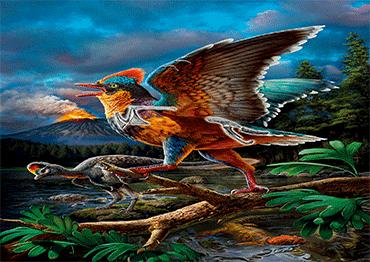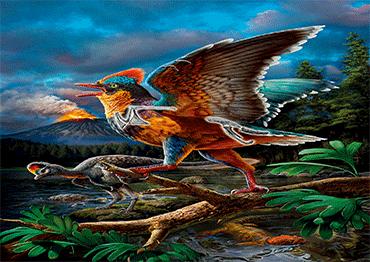In a remarkable discovery, a team of Chinese scientists unearthed the fossil of a bird that lived around 150 million years ago during the Jurassic period, which they believe could change the prevailing understanding of bird evolution.
The fossil was discovered in 2023 during a scientific expedition conducted by the Institute of Vertebrate Paleontology and Paleoanthropology (IVPP) of the Chinese Academy of Sciences (CAS) and the Fujian Institute of Geological Survey, in Zhenghe County, Fujian Province. The newly identified bird, called Baminornis zhenghensis, is named after where it was discovered – Bamin is the ancient name of Fujian. The new discoveries “suggest an earlier origin of birds and a radiation of early birds in the Jurassic,” noted the team in their research paper published by Nature in February.
According to Professor Wang Min, who led the excavation, the region was a swamp in the Jurassic and is rich in dinosaur fossils. In October 2022, Wang and his team discovered a bird-like dinosaur the size of a pheasant. It had elongated legs and arms much like wings. Named Fujianvenator prodigiosus, the Jurassic creature belongs to a grouping called avialans that includes all birds and their closest nonavian dinosaur relatives. The finding, published in Nature in September 2023, provided new insights into the early evolution of birds, though it is still far from modern birds.
Encouraged by the finding, Wang’s team conducted further excavations, finally discovering Baminornis in October 2023. About 15 centimeters long and weighing 100 grams, the species has some striking features, including a short tail with a fused bone structure called a pygostyle, which is also found in modern birds.
Wang told NewsChina that the short tail is a distinctive feature that sets modern birds apart from reptiles such as lizards and crocodiles and is considered a universal feature of existing birds. The short tail helps shift the body’s center of gravity forward, aiding in maintaining body posture during flight.
“The emergence of the pygostyle is a landmark event in the evolution of birds from dinosaurs,” Wang said, adding that the presence of the pygostyle in Baminornis indicates the body structure of modern birds had already formed as early as the Jurassic, pushing back the appearance of this feature by 20 million years.
Previously, fossils of the oldest short-tailed birds were dated to around 130 million years ago, such as the Cretaceous-era Eoconfuciusornis zhengi discovered in Hebei Province. It is the oldest known bird to have a beak and no teeth.
Wang’s study, published in Nature on February 12, 2025, challenged the status of Archaeopteryx. Discovered in 1861 in Germany, Archaeopteryx is widely accepted as the oldest bird, and the transitional species between dinosaurs and birds. The species lived in the same period as Baminornis.
But in recent years, many scientists have started to question whether Archaeopteryx should be classified as a bird or a dinosaur given its long tail and other dinosaur-like features.
“The primary basis for classifying Archaeopteryx as a bird is the presence of feathers on its body. Animals with feathers are generally categorized as birds. However, with a long tail, Archaeopteryx resembles non-avian dinosaurs, while birds are typically associated with short tails,” said Xu Xing, a paleontologist from the IVPP and a co-author of the study.
Xu noted that in recent years, several small dinosaurs resembling Archaeopteryx have been discovered in China and other parts of the world. These dinosaurs not only have feathers but also share similar skeletal structures with Archaeopteryx, including long tails.
In a study led by Xu, which was published in Nature in July 2011, Xu reported a new Archaeopteryx-like theropod found in China. He argued that many features found in Archaeopteryx, formerly regarded to have evolved for the purpose of flight, such as long and robust forelimbs, can also be found in non-avian relatives of birds, which challenged the centrality of Archaeopteryx in the transition to birds.
By contrast, Baminornis has more advanced features, including the short tail and shoulder and pelvic girdle features, making it resemble birds found in the later Cretaceous period that spanned from 145 to 66 million years ago. “Baminornis is the world’s only definitive Jurassic bird,” Xu said, “Its discovery has opened a window that allows scientists to glimpse the previously unknown world of Jurassic birds.”
Zhou Zhonghe, another co-author of the study and CAS academician, told NewsChina that a major difficulty in understanding bird evolution is the rarity of bird fossils. Fossilization requires an animal to be quickly buried in sediment, a process usually involving water bodies such as rivers, lakes or oceans. Unlike land-dwelling creatures, which are more likely to die near rivers and lakes, where their remains can be quickly buried and preserved, birds often live in forests or open areas, so the chances they will be buried quickly are very low, Zhou said.
Moreover, birds are lightweight and have hollow bones, which are more fragile and less likely to survive the fossilization process. The Baminornis fossil, for example, only preserves parts of the bird’s skeleton, including its shoulder and hip bones, while its skull is missing, making it impossible for scientists to study its diet and whether it had a beak or teeth.
Based on other fossils found in the area, the team believes Baminornis lived in a swampy environment alongside dinosaurs, reptiles, turtles and fish. During their excavation, the scientists also discovered a solitary wishbone fossil, which resembles those of the Ornithuromorpha (birds with features closer to modern birds such as a pygostyle) from the Cretaceous period. According to Wang, the wishbone appeared to belong to a separate bird species living in the Jurassic. However, given its poor preservation, the researchers refrained from giving the new species a name.
“If the wishbone fossil indeed belongs to an Ornithuromorpha, it suggests that not only the origin of this group of birds can be traced to at least 150 million years ago, but the appearance of more primitive bird groups would be pushed even further back,” Wang said, noting that the emergence of the earliest birds could also be traced to possibly 172 million to 164 million years ago.
Moreover, if there were multiple bird species in the region, it could suggest that birds were already diversified by the end of Jurassic period and that avian evolution had already taken place millions of years before Baminornis and Archaeopteryx appeared.
“The evolution of birds represents a pivotal event in the history of life on Earth,” Professor Xu said. “The discovery of Baminornis sheds new light on the origins of birds and how they came to dominate the skies of our planet.”

 Old Version
Old Version
